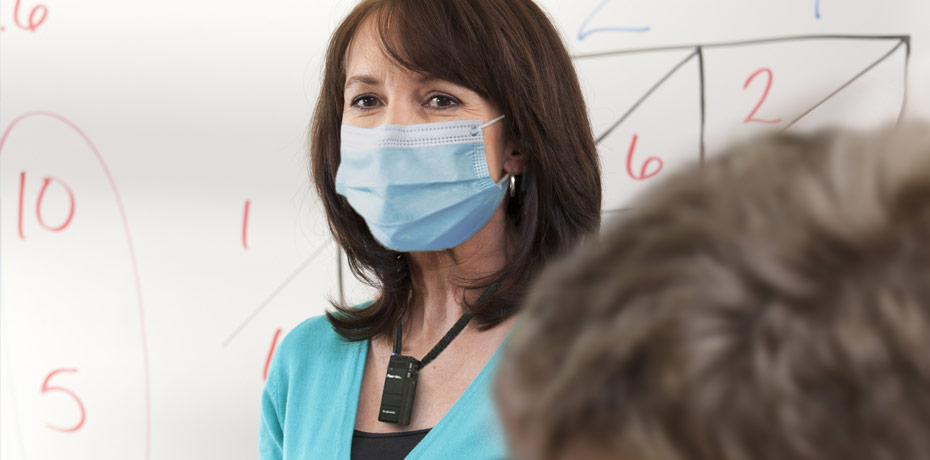The Covid-19 pandemic has resulted in requirements for physical distancing and the use of PPE, such as face masks, by Teachers. While doing much to prevent the spread of COVID-19 these requirements unfortunately reduce the ability of students to hear their teacher. In addition, face masks have the potential to increase teacher vocal strain as a result of talking louder to compensate for the coverings and distancing. In the past, students with reduced hearing typically use remote microphone technology coupled to their personal hearing devices to improve auditory access to instruction. A similar system (known as a classroom audio system) that delivers the teacher’s voice to a speaker is recommended to support all students now facing reduced auditory access imposed by distance and face masks.
- Research has demonstrated that use off face coverings (such as masks) reduces the clarity of speech. Access to clear speech, including soft high frequency consonants (such as “P”, “SH”, “F” and “S”), is critical for children’s early language and literacy development and overall academic achievement.
- Basic speech acoustics show the greater the distance between the speaker and the listener, the message becomes more challenging for individuals to hear and comprehend. When background noise is introduced spoken communication becomes even more challenging for both the listener and the speaker. Younger children, English language learners, and students with hearing, language, or learning concerns are placed at an even greater disadvantage.
- Most of a student’s school day, up to 56%, is spent engaged in listening activities. The purpose of a classroom audio systems is to evenly distribute spoken communications and curricular content throughout the learning space or classroom. The use of such systems improves the overall signal to noise ratio; thus, providing the learners with enhanced speech recognition and, therefore, a greater opportunity to learn.
- Classrooms with multiple hard surfaces often cause “reverberation” which smears speech sounds together making it difficult to understand. In some situations, the poor acoustics may be exacerbated by a classroom audio system. Educational audiologists employed by, or contracted with school systems, have the expertise and equipment to measure reverberation and assure the classroom will benefit from and audio system. (Note, Duplicom, in conjunction with Lightspeed) can assist schools with such measurements.
Lightspeed’s pendant microphone combined with a Redcat, Topcat or 955 classroom audio systems overcomes the audibility and intelligibility challenges brought on by masks and social distance (mentioned above). If you would like to learn more about Lightspeed solutions please contact us.
Note, the above blog post is an abbreviated version of “Covid-19: The Use of Classroom Audio Distribution Systems (CADS) to Improve Auditory Access for All Students” published by the Education Audiology Association.

